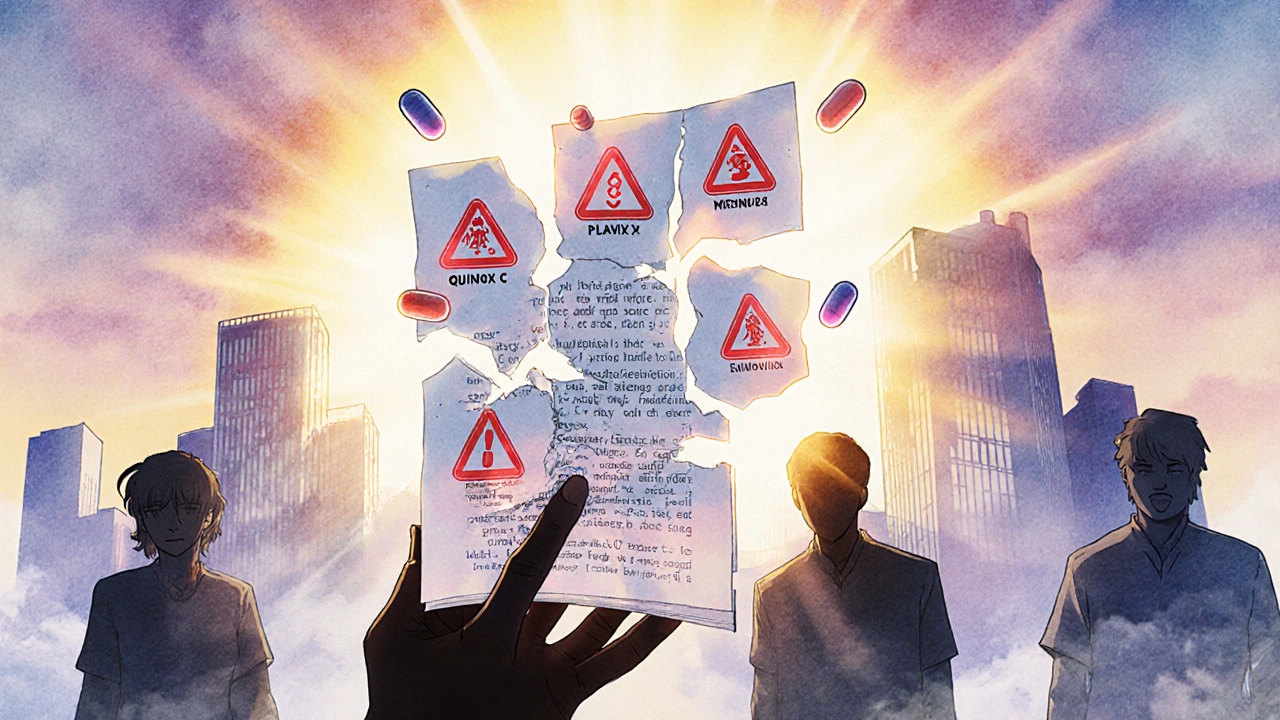Medication-Induced TTP Risk Checker
This tool helps identify potential risk of medication-induced TTP based on your current medications and symptoms. TTP is a life-threatening condition that requires immediate medical attention.
Check Your Medication Risk
Enter medications you're currently taking, separated by commas. Common risk factors include quinine (tonic water), Plavix, ticlopidine, cyclosporine, and mitomycin C.
When you take a pill for a headache, a muscle cramp, or a chronic condition, you expect relief-not a life-threatening emergency. But for some people, common medications can trigger thrombotic thrombocytopenic purpura (TTP), a rare but deadly reaction that attacks the blood and organs. It doesn’t happen often, but when it does, it moves fast. Without quick action, it can kill within days.
What Is Drug-Induced TTP?
TTP is a blood disorder where tiny clots form in small blood vessels all over the body. These clots use up platelets, leaving too few to stop normal bleeding. At the same time, red blood cells get shredded as they squeeze through the blocked vessels. This causes severe anemia, bruising, organ damage, and sometimes brain bleeding.
It’s not caused by genetics or infection. In drug-induced TTP, a medication is the trigger. Over 300 drugs have been linked to it, but only about 20 have strong proof of causing it. The most dangerous include quinine (found in tonic water), clopidogrel (Plavix), ticlopidine, cyclosporine, and mitomycin C. Even over-the-counter products can be risky. One patient developed TTP after drinking three glasses of tonic water a day for three weeks.
How It Happens: Two Different Ways
Not all drug-induced TTP works the same way. There are two main types, and knowing the difference changes how it’s treated.
Immune-mediated TTP happens when the drug tricks the body into making antibodies that attack platelets. These antibodies only activate when the drug is present. That’s why someone can take a medication for months without problems-and then suddenly crash after taking it again. Quinine, clopidogrel, and ticlopidine work this way. The body doesn’t react to the drug itself, but to the drug-platelet combo. This type can come on suddenly, often within days of starting the drug.
Dose-dependent TTP is different. It’s not about the immune system. It’s about the drug slowly poisoning the lining of blood vessels. Cyclosporine and mitomycin C fall into this category. Symptoms don’t show up until after months of use-usually 6 to 12 months. The damage builds up over time. This type doesn’t respond well to plasma exchange. Stopping the drug is the only real fix.
Warning Signs You Can’t Ignore
TTP doesn’t always look like a typical illness. It’s often mistaken for the flu, sepsis, or even a simple case of low platelets (ITP). But there are five key signs to watch for:
- Unexplained bruising or tiny red dots on the skin (petechiae)
- Fatigue, pale skin, or shortness of breath (signs of anemia)
- Confusion, headaches, seizures, or slurred speech (neurological damage)
- Dark urine or jaundice (from broken-down red blood cells)
- High blood pressure or kidney problems
If you’re on a medication and suddenly develop two or more of these, get tested immediately. Don’t wait. A blood smear showing schistocytes (shattered red blood cells) and a platelet count under 50,000 is a red flag. LDH levels above 500 U/L and undetectable haptoglobin confirm hemolytic anemia.

Which Medications Are the Biggest Risks?
Not all drugs carry the same danger. Here are the top offenders, based on real-world data from thousands of cases:
- Quinine: Found in tonic water and some leg cramp remedies. Causes 1 case per 10,000 prescriptions. The FDA and EMA now require black box warnings. Even 2-3 glasses of tonic water daily can trigger it.
- Clopidogrel (Plavix): Used to prevent heart attacks. Risk is low (1 in 26,000), but it’s common. Symptoms usually appear within 2 weeks.
- Ticlopidine: Older drug, mostly replaced by clopidogrel. Still in use in some countries. Risk: 1 in 1,600. Led to a $500 million sales drop after warnings.
- Cyclosporine: Used in transplant patients. Risk jumps to 1.5-15% if dose exceeds 5 mg/kg/day.
- Mitomycin C: A chemotherapy drug. Causes TTP after months of use. Recovery can take months, even after stopping.
- Biologics: Newer drugs like adalimumab (Humira) and checkpoint inhibitors (Keytruda, Opdivo) now account for nearly 30% of recent cases.
What’s scary is that some of these drugs are taken daily for years. People don’t connect their symptoms to a medication they’ve been on for six months. That’s why diagnosis is often delayed-72% of patients are first misdiagnosed.
How It’s Diagnosed and Treated
There’s no single test. Diagnosis relies on a combination of symptoms, blood tests, and timing. Doctors look for:
- Platelet count under 150,000 (often under 50,000)
- Schistocytes on blood smear
- High LDH, low haptoglobin
- No other cause (like infection, pregnancy, or cancer)
ADAMTS13 enzyme testing confirms immune-mediated cases-if levels are below 10%, it’s almost certainly drug-induced TTP. But you don’t wait for results. If TTP is suspected, treatment starts within hours.
For immune-mediated cases: Plasma exchange is the gold standard. It removes the bad antibodies and replaces them with healthy plasma. Done daily, it saves over 80% of patients. Caplacizumab, a newer drug, can speed up recovery by 78%-but it costs $18,500 per course and isn’t available everywhere.
For dose-dependent cases: Plasma exchange doesn’t help much. The only cure is stopping the drug. Supportive care-fluids, dialysis, blood transfusions-keeps the patient alive while the body repairs itself. Recovery can take months.
Delaying treatment by even 24 hours can be deadly. In one case, a 62-year-old woman developed brain bleeding after starting quinine for leg cramps. Her platelets dropped to 8,000 in 72 hours. She survived-but only because she got to the hospital fast.

What You Can Do to Stay Safe
If you’re taking any of these medications, here’s what matters:
- Know your meds. Check if you’re on quinine-yes, even in tonic water. Read labels. Some brands list it as “natural flavoring.”
- Track new symptoms. If you start feeling unusually tired, dizzy, or confused after starting a new drug, don’t brush it off.
- Speak up. Tell your doctor about every pill, supplement, or tonic you take. Many cases come from OTC products people don’t think of as “medications.”
- Ask about alternatives. If you’re on ticlopidine, ask if clopidogrel is an option. If you’re on cyclosporine, ask about newer immunosuppressants with lower TTP risk.
- Don’t ignore follow-ups. If you’re on long-term meds like cyclosporine or chemotherapy, regular blood tests are non-negotiable.
And if you’ve had drug-induced TTP before? Never take the triggering drug again-even years later. The antibodies can stay in your system forever. One re-exposure is all it takes to trigger it again.
Why This Is Still Underdiagnosed
Despite advances, the death rate hasn’t dropped since the 1990s. Why? Because doctors still don’t think of TTP fast enough. A 2021 study found that 40% of cases are missed at first. Emergency rooms see thousands of patients with low platelets every year. Most are ITP or infection. TTP is rare-but deadly. And it doesn’t wait.
The FDA reports a 37% rise in TTP cases from 2015 to 2022. More drugs are being linked. More patients are surviving-but only if they’re caught in time.
Education is the missing link. Medical schools don’t emphasize TTP enough. Primary care doctors aren’t trained to spot the subtle signs. Patients don’t know to ask. The result? Too many people die because no one connected the dots.
What’s Next?
Scientists are working on faster tests. Right now, ADAMTS13 results take 1-3 days. New point-of-care tests could give answers in 20 minutes. Genetic screening might soon identify who’s at higher risk-like people with the HLA-DRB1*11:01 gene, who are 4 times more likely to react to quinine.
Pharmaceutical companies now test new drugs for TTP risk before they hit the market. The FDA requires endothelial toxicity studies for cancer drugs. That’s progress.
But the real solution is awareness. If you’re on a medication and feel something’s off-trust your gut. Ask for a blood smear. Ask about platelets. Ask about TTP. Your life could depend on it.
Can tonic water really cause TTP?
Yes. Quinine, the bitter ingredient in tonic water, has caused TTP in multiple documented cases. People who drank 2-3 glasses daily for weeks developed life-threatening symptoms. Even though the amount of quinine is small, it’s enough to trigger the immune reaction in sensitive individuals. The FDA and European regulators now warn about this risk.
Is TTP from medication permanent?
No. Once the triggering drug is stopped and treatment begins, most patients recover. Platelet counts usually rebound within days to weeks. But if the drug is taken again-even years later-the reaction can return. Some people develop lasting fatigue or kidney issues, but full recovery is common with prompt care.
Can I get tested for TTP risk before taking a drug?
Not routinely. There’s no standard genetic or blood test to predict who will react. The only way to know is to monitor for symptoms after starting the drug. If you’ve had TTP before from a specific medication, you should never take it again.
How fast does drug-induced TTP develop?
It depends on the drug. For immune-mediated cases like quinine or clopidogrel, symptoms can appear in as little as 3-7 days. For dose-dependent drugs like cyclosporine or mitomycin C, it takes 6-12 months of use. The key is timing: if symptoms start shortly after a new drug is introduced, TTP should be suspected.
What’s the survival rate for drug-induced TTP?
With prompt treatment, survival is 80-90%. Without treatment, it’s over 90% fatal. The biggest risk isn’t the disease itself-it’s delayed diagnosis. Patients who wait more than 48 hours to get treatment have a much higher chance of death or permanent damage.


Hi, I'm Caden Lockhart, a pharmaceutical expert with years of experience in the industry. My passion lies in researching and developing new medications, as well as educating others about their proper use and potential side effects. I enjoy writing articles on various diseases, health supplements, and the latest treatment options available. In my free time, I love going on hikes, perusing scientific journals, and capturing the world through my lens. Through my work, I strive to make a positive impact on patients' lives and contribute to the advancement of medical science.